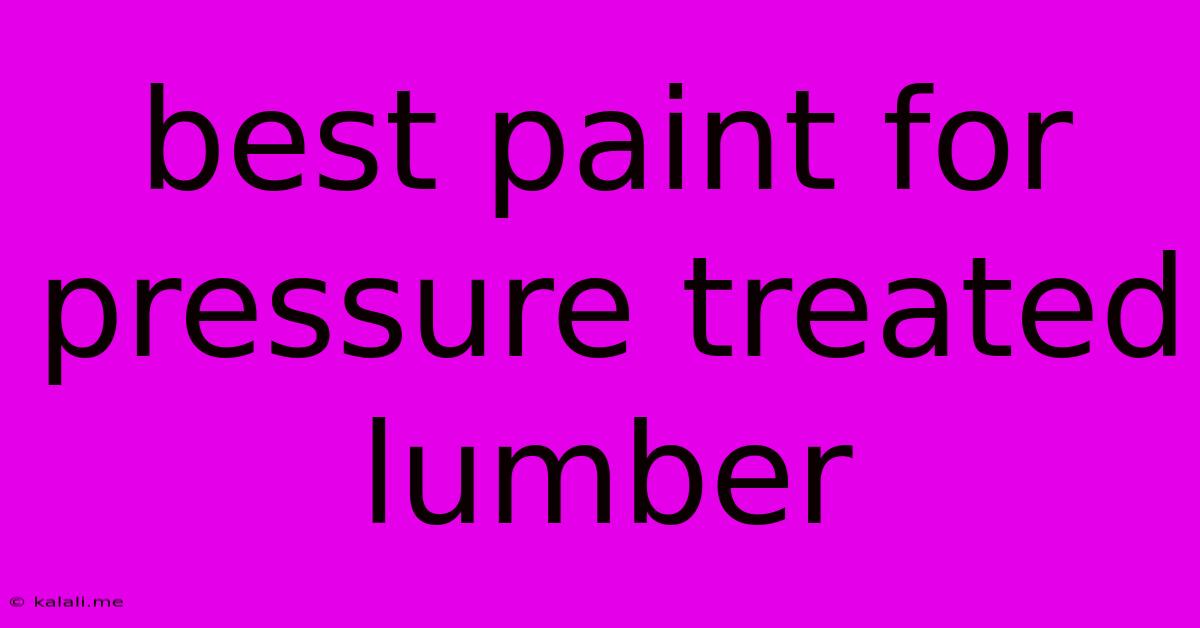Best Paint For Pressure Treated Lumber
Kalali
Jun 01, 2025 · 4 min read

Table of Contents
Best Paint for Pressure Treated Lumber: A Comprehensive Guide
Choosing the right paint for pressure-treated lumber is crucial for achieving a long-lasting, beautiful finish. Pressure-treated wood, while durable, requires a specific type of paint to withstand the chemicals and moisture inherent in the material. This guide explores the best paint options, preparation techniques, and application tips to ensure your project's success. Learn how to select the ideal paint and protect your investment.
Understanding Pressure-Treated Lumber
Pressure-treated lumber is infused with preservatives, typically copper azole, chromated copper arsenate (CCA), or micronized copper quat (MCQ), to protect against rot, insects, and decay. These chemicals can leach out over time, potentially affecting the adhesion of certain paints. Therefore, selecting a paint specifically designed for exterior use and compatible with treated lumber is essential. Ignoring this critical aspect can lead to premature paint failure, peeling, and blistering.
Choosing the Right Paint: Key Considerations
Several factors influence your paint selection:
-
Type of Paint: Oil-based paints were traditionally preferred for their durability and moisture resistance. However, water-based acrylic paints have gained popularity due to their low odor, ease of cleanup, and superior flexibility, making them less prone to cracking. Both options offer excellent protection when correctly applied to prepared wood.
-
Durability: Look for paints with high durability ratings, indicating resistance to fading, chipping, and peeling. Paints specifically formulated for exterior use and high-moisture environments are ideal. Consider the climate in your area – harsher weather conditions necessitate more durable paints.
-
Primer: While some paints offer a built-in primer, applying a separate primer specifically designed for pressure-treated lumber is highly recommended. This creates a barrier, preventing the leaching of preservatives and improving the paint's adhesion. This is especially important with water-based paints.
-
VOC Levels: Volatile organic compounds (VOCs) are released into the air during paint application. Opt for low-VOC or zero-VOC paints to minimize environmental impact and improve indoor air quality, especially if painting near living spaces.
Best Paint Types for Pressure-Treated Lumber
While the "best" paint depends on individual needs and preferences, these types consistently perform well:
-
100% Acrylic Latex Paints: These paints offer excellent flexibility, durability, and mildew resistance, making them a top choice for pressure-treated wood. Their water-based nature makes them easier to clean up than oil-based paints.
-
Oil-Based Alkyd Paints: Oil-based paints provide superior protection against moisture and offer excellent durability, although they require more thorough preparation and longer drying times. They may also have a stronger odor during application.
-
Specialty Paints for Exterior Wood: Look for paints explicitly marketed for exterior wood or pressure-treated lumber. These paints are usually formulated to withstand the challenges of outdoor exposure and the potential interactions with preservatives.
Preparing the Lumber for Painting
Proper preparation is paramount for successful paint adhesion and long-lasting results. Follow these steps:
-
Cleaning: Thoroughly clean the wood surface using a pressure washer or stiff brush and soap and water to remove dirt, debris, mildew, and any loose splinters. Allow the wood to dry completely.
-
Neutralization: If the wood is very new, consider neutralizing the chemicals. While some debate exists, this step can help improve paint adhesion in certain cases. Consult with a paint professional for guidance on appropriate neutralizers.
-
Priming: Apply a high-quality primer designed for pressure-treated lumber. Allow it to dry completely before applying the top coat. This step is crucial for preventing bleeding and improving the paint's adherence.
Applying the Paint
-
Application Method: Use a high-quality brush, roller, or sprayer for even paint application. Sprayers are ideal for large projects, while brushes provide more control for detailed work.
-
Multiple Coats: Apply at least two coats of paint for optimal protection and color consistency. Allow each coat to dry completely before applying the next.
-
Weather Conditions: Avoid painting in direct sunlight, extreme heat, or rain. Ideal painting conditions are mild temperatures and low humidity.
By carefully selecting the right paint and following these preparation and application techniques, you can ensure a long-lasting, beautiful finish on your pressure-treated lumber projects. Remember to always refer to the manufacturer's instructions for specific product recommendations and application details.
Latest Posts
Latest Posts
-
Difference Between A Chorus And A Refrain
Jun 03, 2025
-
How Much In Box Of Powdered Sugar
Jun 03, 2025
-
Normalizing Flows To Infer The Likelihood
Jun 03, 2025
-
What Does God Say About Eating Meat
Jun 03, 2025
-
Do You Need To Season Stainless Steel Pans
Jun 03, 2025
Related Post
Thank you for visiting our website which covers about Best Paint For Pressure Treated Lumber . We hope the information provided has been useful to you. Feel free to contact us if you have any questions or need further assistance. See you next time and don't miss to bookmark.